Estimation of the Setting and Infrastructure Criterion of the UI GreenMetric Ranking Using Unmanned Aerial Vehicles
Abstract
:1. Introduction
2. Materials and Methods
2.1. Study Area
2.2. Tree Inventory and University Population
2.3. Acquisition and Processing of Data from Unmanned Aerial Vehicles
2.4. Classification of the Point Cloud
2.5. Reconstruction of the Forest Surface and Parameters
2.6. Aerial Biomass, Carbon, and CO2 Equivalents
- AGB = Aerial biomass, dry matter on the ground.
- exp = Exponent in base e (power).
- Ln = Natural logarithm.
- ρ = Density of the wood (g/cm3).
- DBH = Diameter at breast height in cm.
- h = Tree height.
- SC = Stored carbon (tons/ha).
- TB = Total biomass (tons/ha).
2.7. Setting and Infrastructure Criterion
- (1)
- Total campus area (m2).
- (2)
- Total campus ground floor area of buildings (m2).
- (3)
- Ratio of open space area to total area.
- (4)
- Total area on campus covered in forest vegetation.
- (5)
- Total area on campus covered in planted vegetation.
- (6)
- Total area on campus for water absorption other than the forest and planted vegetation.
- (7)
- Total open space area divided by the total campus population.
- (8)
- Carbon fixation and CO2 equivalents in the forest vegetation of the campus (tons/ha).
2.8. UAV–GreenMetric Methodology Workflow
3. Results
3.1. GreenMetric Data Obtained
3.2. Estimation of Biomass and Carbon Sequestration
4. Discussion
5. Conclusions
Author Contributions
Funding
Acknowledgments
Conflicts of Interest
References
- Khraim, H.S.; Al-Afaishat, T.M. The Effect of Green Marketing on Students’ Selection of Private Universities in Jordan. Multicult. Educ. 2021, 7. [Google Scholar] [CrossRef]
- Fissi, S.; Romolini, A.; Gori, E.; Contri, M. The path toward a sustainable green university: The case of the University of Florence. J. Clean. Prod. 2021, 279, 123655. [Google Scholar] [CrossRef]
- Marques, C.; BACHEGA, S.J.; Tavares, D.M. Framework proposal for the environmental impact assessment of universities in the context of Green IT. J. Clean. Prod. 2019, 241, 118346. [Google Scholar] [CrossRef]
- Grindsted, T. Sustainable universities–from declarations on sustainability in higher education to national law. Environ. Econ. 2011, 2, 29–36. [Google Scholar] [CrossRef] [Green Version]
- Suwartha, N.; Sari, R.F. Evaluating UI GreenMetric as a tool to support green universities development: Assessment of the year 2011 ranking. J. Clean. Prod. 2013, 61, 46–53. [Google Scholar] [CrossRef]
- Khaple, A.K.; Devagiri, G.M.; Veerabhadraswamy, N.; Babu, S.; Mishra, S.B. Chapter 6—Vegetation biomass and carbon stock assessment using geospatial approach. In Forest Resources Resilience and Conflicts; Kumar Shit, P., Pourghasemi, H.R., Adhikary, P.P., Bhunia, G.S., Sati, V.P., Eds.; Elsevier: Amsterdam, The Netherlands, 2021; pp. 77–91. [Google Scholar] [CrossRef]
- Asner, G.P. Tropical forest carbon assessment: Integrating satellite and airborne mapping approaches. Environ. Res. Lett. 2009, 4, 034009. [Google Scholar] [CrossRef]
- Asner, G.P.; Mascaro, J. Mapping tropical forest carbon: Calibrating plot estimates to a simple LiDAR metric. Remote Sens. Environ. 2014, 140, 614–624. [Google Scholar] [CrossRef]
- Tian, Y.; Huang, H.; Zhou, G.; Zhang, Q.; Tao, J.; Zhang, Y.; Lin, J. Aboveground mangrove biomass estimation in Beibu Gulf using machine learning and UAV remote sensing. Sci. Total Environ. 2021, 781, 146816. [Google Scholar] [CrossRef]
- Mao, P.; Qin, L.; Hao, M.; Zhao, W.; Luo, J.; Qiu, X.; Xu, L.; Xiong, Y.; Ran, Y.; Yan, C.; et al. An improved approach to estimate above-ground volume and biomass of desert shrub communities based on UAV RGB images. Ecol. Indic. 2021, 125, 107494. [Google Scholar] [CrossRef]
- Abdullah, M.M.; Al-Ali, Z.M.; Abdullah, M.T.; Srinivasan, S.; Assi, A.T.; Al Atiqi, S. Investigating the applicability of UAVs in characterizing desert shrub biomass and developing biological indicators for the selection of suitable revegetation sites. J. Environ. Manag. 2021, 288, 112416. [Google Scholar] [CrossRef]
- Fonstad, M.A.; Dietrich, J.T.; Courville, B.C.; Jensen, J.L.; Carbonneau, P.E. Topographic structure from motion: A new development in photogrammetric measurement. Earth Surf. Process. Landf. 2012, 38, 421–430. [Google Scholar] [CrossRef] [Green Version]
- Abdullah, M.M.; Al-Ali, Z.M.; Srinivasan, S. The use of UAV-based remote sensing to estimate biomass and carbon stock for native desert shrubs. MethodsX 2021, 8, 101399. [Google Scholar] [CrossRef] [PubMed]
- Sankey, T.T.; Leonard, J.; Moore, M.M.; Sankey, J.B.; Belmonte, A. Carbon and ecohydrological priorities in managing woody encroachment: An UAV perspective 63 years after a control treatment. Environ. Res. Lett. 2021, 16, 37. [Google Scholar] [CrossRef]
- Chianucci, F.; Marchino, L.; Bidini, C.; Giorcelli, A.; Coaloa, D.; Chiarabaglio, P.; Giannetti, F.; Chirici, G.; Tattoni, C. Dataset of tree inventory and canopy structure in poplar plantations in Northern Italy. Ann. Silvicul. Res. 2021, 46, 4. [Google Scholar]
- Song, Y.; Wang, J.; Shan, B. Estimation of Winter Wheat Yield from UAV-Based Multi-Temporal Imagery Using Crop Allometric Relationship and SAFY Model. Drones 2021, 5, 78. [Google Scholar] [CrossRef]
- Fakhri, S.A.; Latifi, H. A Consumer Grade UAV-Based Framework to Estimate Structural Attributes of Coppice and High Oak Forest Stands in Semi-Arid Regions. Remote Sens. 2021, 13, 4367. [Google Scholar] [CrossRef]
- Matese, A.; Berton, A.; Chiarello, V.; Dainelli, R.; Nati, C.; Pastonchi, L.; Toscano, P.; Di Gennaro, S.F. Determination of Riparian Vegetation Biomass from an Unmanned Aerial Vehicle (UAV). Forests 2021, 12, 1566. [Google Scholar] [CrossRef]
- Hernández-Cole, J.; Ortiz-Malavassi, E.; Moya, R.; Murillo, O. Evaluation of Unmanned Aerial Vehicles (UAV) as a Tool to Predict Biomass and Carbon of Tectona grandis in Silvopastoral Systems (SPS) in Costa Rica. Drones 2021, 5, 47. [Google Scholar] [CrossRef]
- Guascal, E.; Rojas, S.; Kirby, E.; Toulkeridis, T.; Fuertes, W.; Heredia, M. Application of Remote Sensing Techniques in the Estimation of Forest Biomass of a Recreation Area by UAV and RADAR Images in Ecuador. In Proceedings of the 2020 Seventh International Conference on eDemocracy & eGovernment (ICEDEG), Buenos Aires, Argentina, 22–24 April 2020; pp. 183–190. [Google Scholar] [CrossRef]
- Fuentes, J. Comparación de Modelos de Altura de la Vegetación para Estimación de Biomasa en un Bosque de Manglar en el Caribe Colombiano; Entorno Geográfico; Universidad del Valle: Cali, Colombia, 2020; pp. 1–18. [Google Scholar]
- Navarro, A.; Young, M.; Allan, B.; Carnell, P.; Macreadie, P.; Ierodiaconou, D. The application of Unmanned Aerial Vehicles (UAVs) to estimate above-ground biomass of mangrove ecosystems. Remote Sens. Environ. 2020, 242, 111747. [Google Scholar] [CrossRef]
- Jones, A.R.; Raja Segaran, R.; Clarke, K.D.; Waycott, M.; Goh, W.S.H.; Gillanders, B.M. Estimating Mangrove Tree Biomass and Carbon Content: A Comparison of Forest Inventory Techniques and Drone Imagery. Front. Mar. Sci. 2020, 6, 784. [Google Scholar] [CrossRef] [Green Version]
- Fernandes, M.R.; Aguiar, F.C.; Martins, M.J.; Rico, N.; Ferreira, M.T.; Correia, A.C. Carbon Stock Estimations in a Mediterranean Riparian Forest: A Case Study Combining Field Data and UAV Imagery. Forests 2020, 11, 376. [Google Scholar] [CrossRef] [Green Version]
- González-Jaramillo, V.; Fries, A.; Bendix, J. AGB Estimation in a Tropical Mountain Forest (TMF) by Means of RGB and Multispectral Images Using an Unmanned Aerial Vehicle (UAV). Remote Sens. 2019, 11, 1413. [Google Scholar] [CrossRef] [Green Version]
- Ye, N.; van Leeuwen, L.; Nyktas, P. Analysing the potential of UAV point cloud as input in quantitative structure modelling for assessment of woody biomass of single trees. Int. J. Appl. Earth Obs. Geoinf. 2019, 81, 47–57. [Google Scholar] [CrossRef]
- Panday, U.S.; Shrestha, N.; Maharjan, S. Estimation of above Ground Forest Biomass Using Ultra High Resolution Uav Images: A Case Study from Barandabhar Forest, Nepal. ISPRS-Int. Arch. Photogramm. Remote. Sens. Spat. Inf. Sci. 2019, XLII-5/W3, 77–83. [Google Scholar] [CrossRef] [Green Version]
- Lin, J.; Wang, M.; Ma, M.; Lin, Y. Aboveground Tree Biomass Estimation of Sparse Subalpine Coniferous Forest with UAV Oblique Photography. Remote Sens. 2018, 10, 1849. [Google Scholar] [CrossRef] [Green Version]
- Puniach, E.; Gruszczyński, W.; Ćwiąkała, P.; Matwij, W. Application of UAV-based orthomosaics for determination of horizontal displacement caused by underground mining. ISPRS J. Photogramm. Remote Sens. 2021, 174, 282–303. [Google Scholar] [CrossRef]
- Biçici, S.; Zeybek, M. An approach for the automated extraction of road surface distress from a UAV-derived point cloud. Autom. Constr. 2021, 122, 103475. [Google Scholar] [CrossRef]
- Elkhrachy, I. Accuracy Assessment of Low-Cost Unmanned Aerial Vehicle (UAV) Photogrammetry. Alex. Eng. J. 2021, 60, 5579–5590. [Google Scholar] [CrossRef]
- Valkaniotis, S.; Papathanassiou, G.; Ganas, A. Mapping an earthquake-induced landslide based on UAV imagery; case study of the 2015 Okeanos landslide, Lefkada, Greece. Eng. Geol. 2018, 245, 141–152. [Google Scholar] [CrossRef]
- Sărășan, A.; Ardelean, A.-C.; Bălărie, A.; Wehrheim, R.; Tabaldiev, K.; Akmatov, K. Mapping burial mounds based on UAV-derived data in the Suusamyr Plateau, Kyrgyzstan. J. Archaeol. Sci. 2020, 123, 105251. [Google Scholar] [CrossRef]
- Jeong, G.Y.; Nguyen, T.N.; Tran, D.K.; Hoang, T.B.H. Applying unmanned aerial vehicle photogrammetry for measuring dimension of structural elements in traditional timber building. Measurement 2020, 153, 107386. [Google Scholar] [CrossRef]
- Fuentes, J.E.; Moya, F.D.; Montoya, O.D. Method for Estimating Solar Energy Potential Based on Photogrammetry from Unmanned Aerial Vehicles. Electronics 2020, 9, 2144. [Google Scholar] [CrossRef]
- Park, J.; Kim, P.; Cho, Y.K.; Kang, J. Framework for automated registration of UAV and UGV point clouds using local features in images. Autom. Constr. 2018, 98, 175–182. [Google Scholar] [CrossRef]
- Lee, G.; Choi, M.; Yu, W.; Jung, K. Creation of river terrain data using region growing method based on point cloud data from UAV photography. Quat. Int. 2019, 519, 255–262. [Google Scholar] [CrossRef]
- Liu, W.; Yang, M.; Xie, M.; Guo, Z.; Li, E.; Zhang, L.; Pei, T.; Wang, D. Accurate Building Extraction from Fused DSM and UAV Images Using a Chain Fully Convolutional Neural Network. Remote Sens. 2019, 11, 2912. [Google Scholar] [CrossRef] [Green Version]
- Al-Najjar, H.A.H.; Kalantar, B.; Pradhan, B.; Saeidi, V.; Halin, A.A.; Ueda, N.; Mansor, S. Land Cover Classification from fused DSM and UAV Images Using Convolutional Neural Networks. Remote Sens. 2019, 11, 1461. [Google Scholar] [CrossRef] [Green Version]
- Mavroulis, S.; Andreadakis, E.; Spyrou, N.-I.; Antoniou, V.; Skourtsos, E.; Papadimitriou, P.; Kasssaras, I.; Kaviris, G.; Tselentis, G.A.; Voulgaris, N.; et al. UAV and GIS based rapid earthquake-induced building damage assessment and methodology for EMS-98 isoseismal map drawing: The June 12, 2017 Mw 6.3 Lesvos (Northeastern Aegean, Greece) earthquake. Int. J. Disaster Risk Reduct. 2019, 37, 101169. [Google Scholar] [CrossRef]
- Nikolakopoulos, K.G.; Soura, K.; Koukouvelas, I.K.; Argyropoulos, N.G. UAV vs classical aerial photogrammetry for archaeological studies. J. Archaeol. Sci. Rep. 2016, 14, 758–773. [Google Scholar] [CrossRef]
- Vacca, G.; Dessì, A.; Sacco, A. The Use of Nadir and Oblique UAV Images for Building Knowledge. ISPRS Int. J. Geo-Inf. 2017, 6, 393. [Google Scholar] [CrossRef] [Green Version]
- Banaszek, A.; Banaszek, S.; Cellmer, A. Possibilities of Use of UAVS for Technical Inspection of Buildings and Constructions. IOP Conf. Series Earth Environ. Sci. 2017, 95, 32001. [Google Scholar] [CrossRef]
- Chen, B.; Chen, Z.; Deng, L.; Duan, Y.; Zhou, J. Building change detection with RGB-D map generated from UAV images. Neurocomputing 2016, 208, 350–364. [Google Scholar] [CrossRef]
- IDEAM. Características Climatológicas de Ciudades Principales y Municipios Turísticos de Colombia; IDEAM: Bogotá, Colombia, 2012; p. 48. Available online: http://www.ideam.gov.co/documents/21021/418894/Caracter%C3%ADsticas+de+Ciudades+Principales+y+Municipios+Tur%C3%ADsticos.pdf/c3ca90c8-1072-434a-a235-91baee8c73fc (accessed on 23 September 2021).
- Alba Marina, T.; Viviana, L.; Jhon Alexander, V.; Angela Cristina, J.; Katherine Lorena, R.; Olga Lucía, D. Inventario Arbóreo del Jardín Botánico Universitario del Campus Meléndez de la Universidad del Valle, Santiago de Cali; Universidad del Valle: Cali, Colombia, 2015. [Google Scholar] [CrossRef]
- Becker, C.; Rosinskaya, E.; Häni, N.; d’Angelo, E.; Strecha, C. Classification of aerial photogrammetric 3D point clouds. Photogramm. Eng. Remote. Sens. 2018, 84, 287–295. [Google Scholar] [CrossRef]
- Wang, Q.; Pang, Y.; Chen, D.; Liang, X.; Lu, J. Lidar biomass index: A novel solution for tree-level biomass estimation using 3D crown information. For. Ecol. Manag. 2021, 499, 119542. [Google Scholar] [CrossRef]
- Lockwood, B.R.; Maxwell, J.T.; Robeson, S.M.; Au, T.F. Assessing bias in diameter at breast height estimated from tree rings and its effects on basal area increment and biomass. Dendrochronologia 2021, 67, 125844. [Google Scholar] [CrossRef]
- Chave, J.; Andalo, C.; Brown, S.; Cairns, M.A.; Chambers, J.Q.; Eamus, D.; Fölster, H.; Fromard, F.; Higuchi, N.; Kira, T.; et al. Tree allometry and improved estimation of carbon stocks and balance in tropical forests. Oecologia 2005, 145, 87–99. [Google Scholar] [CrossRef] [PubMed]
- Phillips, J.; Duque, A.; Cabrera, K.; Yepes, A.; Navarrete, D.; García, M.; Álvarez, E.; Cabrera, E.; Cárdenas, D.; Galindo, G. Estimación de las Reservas Potenciales de Carbono Almacenadas en la Biomasa Aérea en Bosques Naturales de Colombia; Instituto de Hidrología: Bogotá, Colombia, 2011; Volume 1, p. 70. [Google Scholar]
- Mohd Zaki, N.A.; Rajuli, M.F.; Latif, Z.A.; Suratman, M.N.; Omar, H.; Norashikin, S.; Zainal, M.Z.; Talib, N. Analysis of Canopy Height Model (CHM) Extraction using Quick Terrain Modeller (QTM) for Tropical Forest Area. IOP Conf. Ser. Earth Environ. Sci. 2020, 540, 012045. [Google Scholar] [CrossRef]
- Brown, S. Measuring, monitoring, and verification of carbon benefits for forest–based projects. Philosophical Transactions of the Royal Society of London. Ser. A Math. Phys. Eng. Sci. 2002, 360, 1669–1683. [Google Scholar] [CrossRef] [PubMed]
- Hergoualc’h, K.; Akiyama, H.; Bernoux, M.; Chirinda, N.; del Prado, A.; Kasimir, A.; MacDonald, J.D.; Ogle, S.M.; Regina, K.; Weerden, T.J.v.d. N2O emissions from managed soils, and CO2 emissions from lime and urea application. In Refinement to the 2006 IPCC Guidelines for National Greenhouse Gas Inventories; Intergovernmental Panel on Climate Change: Bangkok, Thailand, 2019; Volume 4, pp. 11.1–11.48. [Google Scholar]
- Díaz Arteaga, A.; Granados, S.; Saldaña Barahona, A. Informe Nacional de Calidad Ambiental Urbana: Áreas Urbanas con Población Superior a 500.000 Habitantes; Ministerio de Ambiente y Desarrollo Sostenible: Bogotá, Colombia, 2014; p. 95.
- Agredo, L. Aproximación a la Huella Ecológica de la Universidad del Valle, Campus Universitario de Meléndez. Bachelor’ Thesis, Universidad del Valle, Cali, Colombia, August 2011. [Google Scholar]
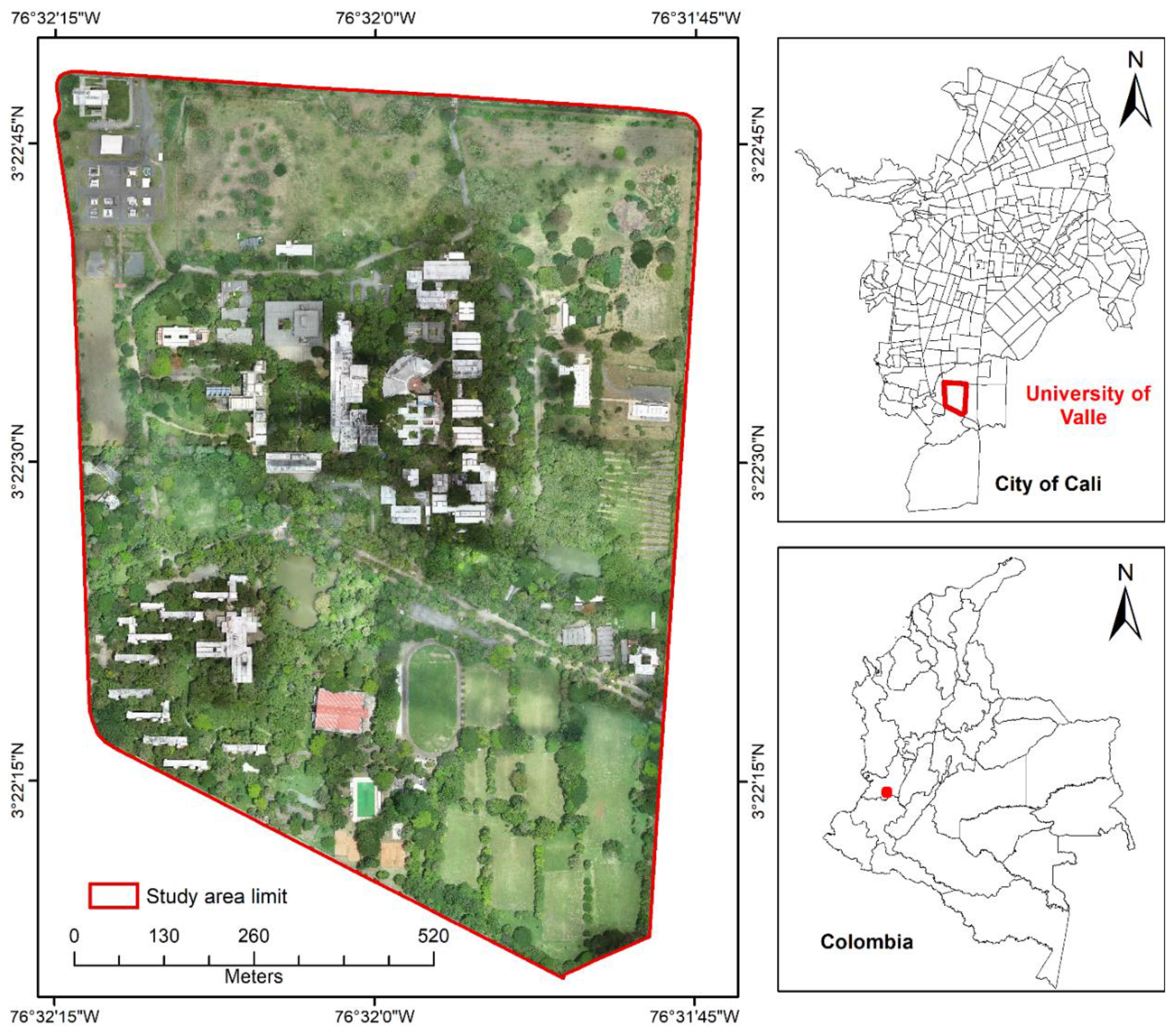
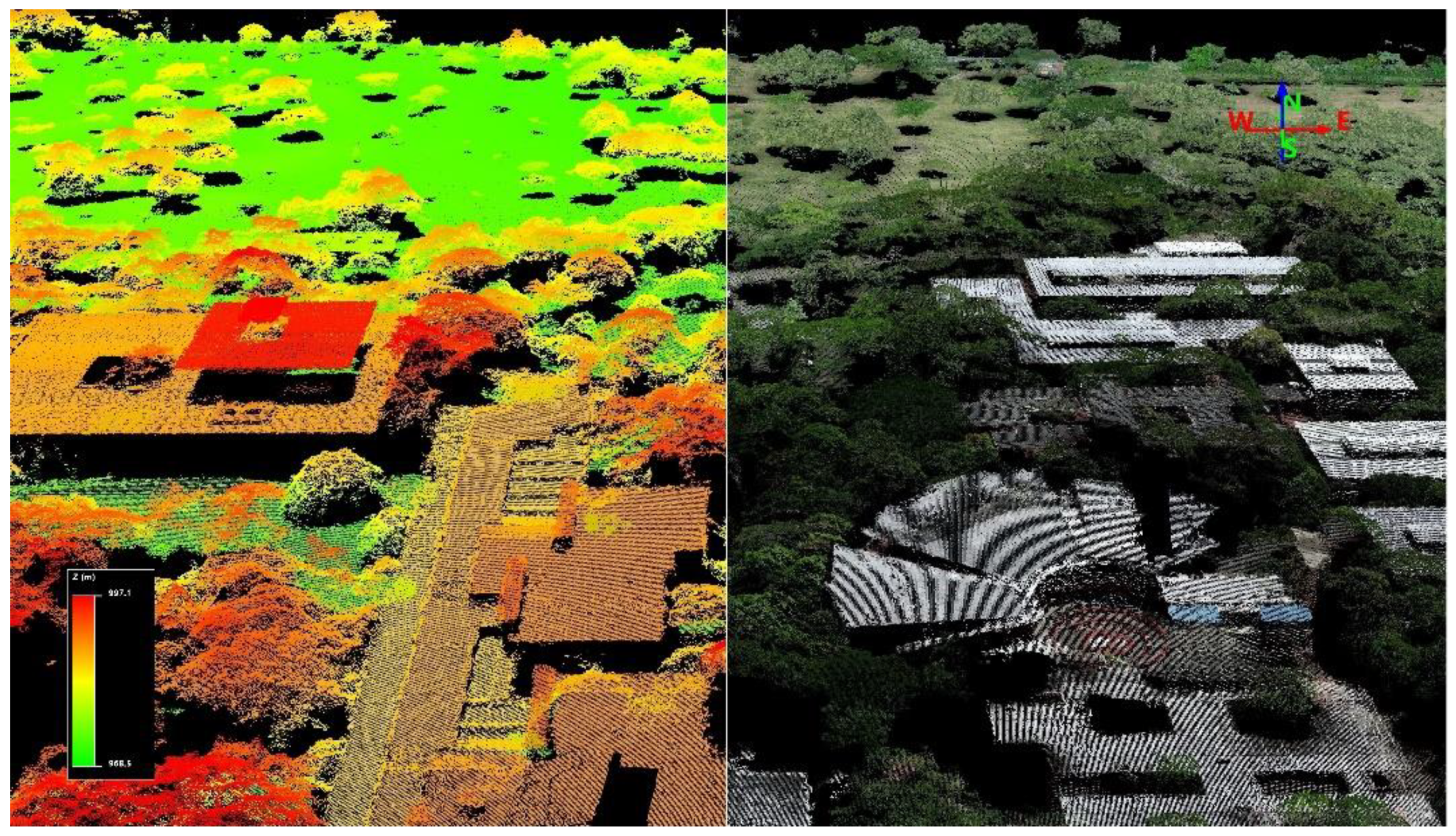
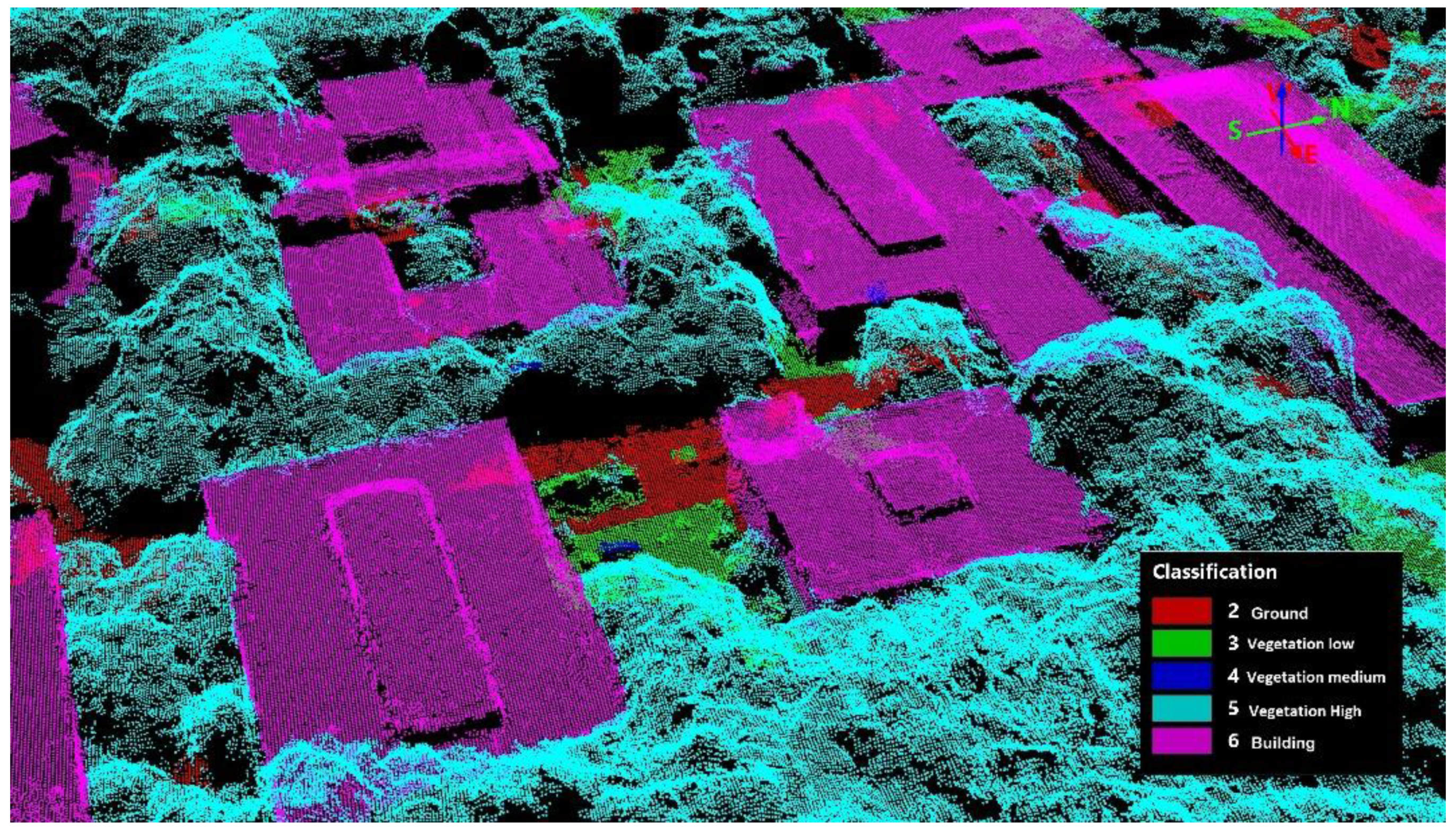
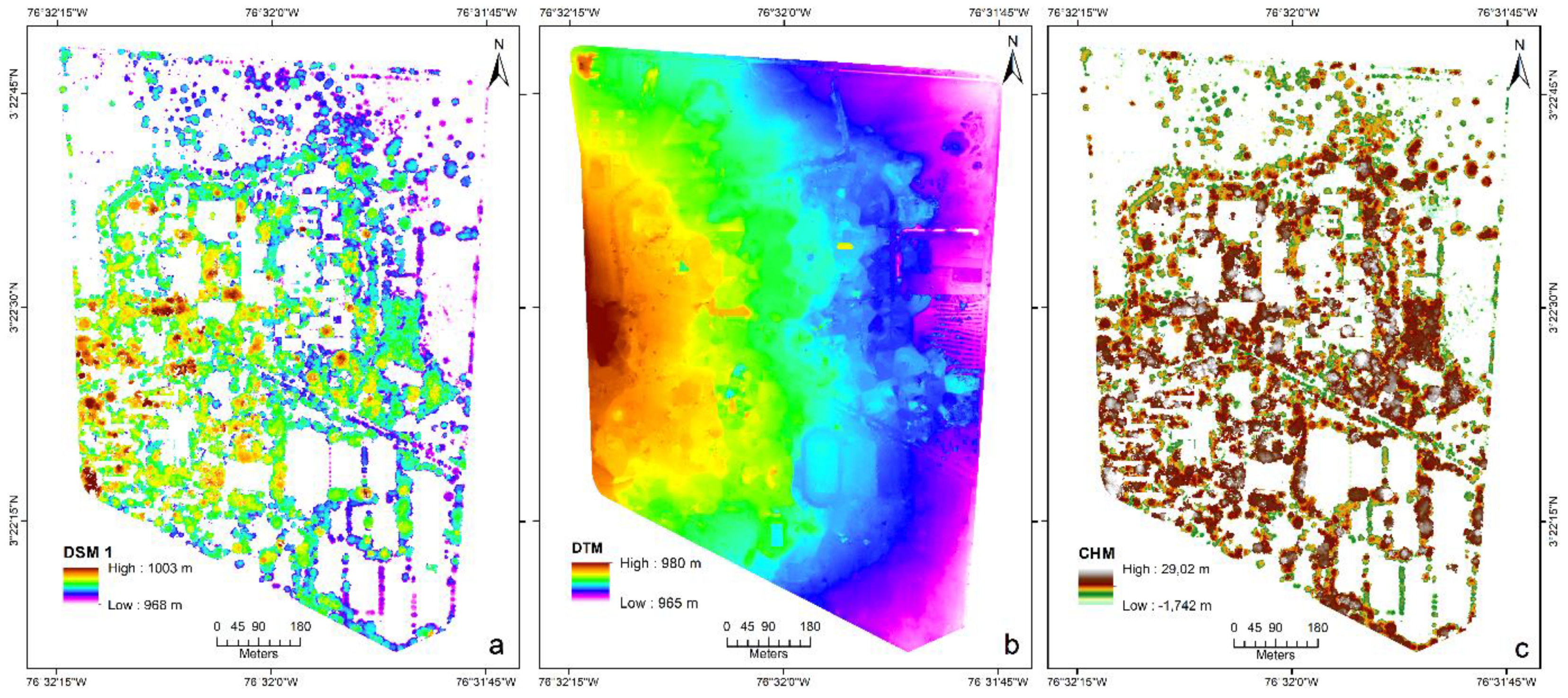


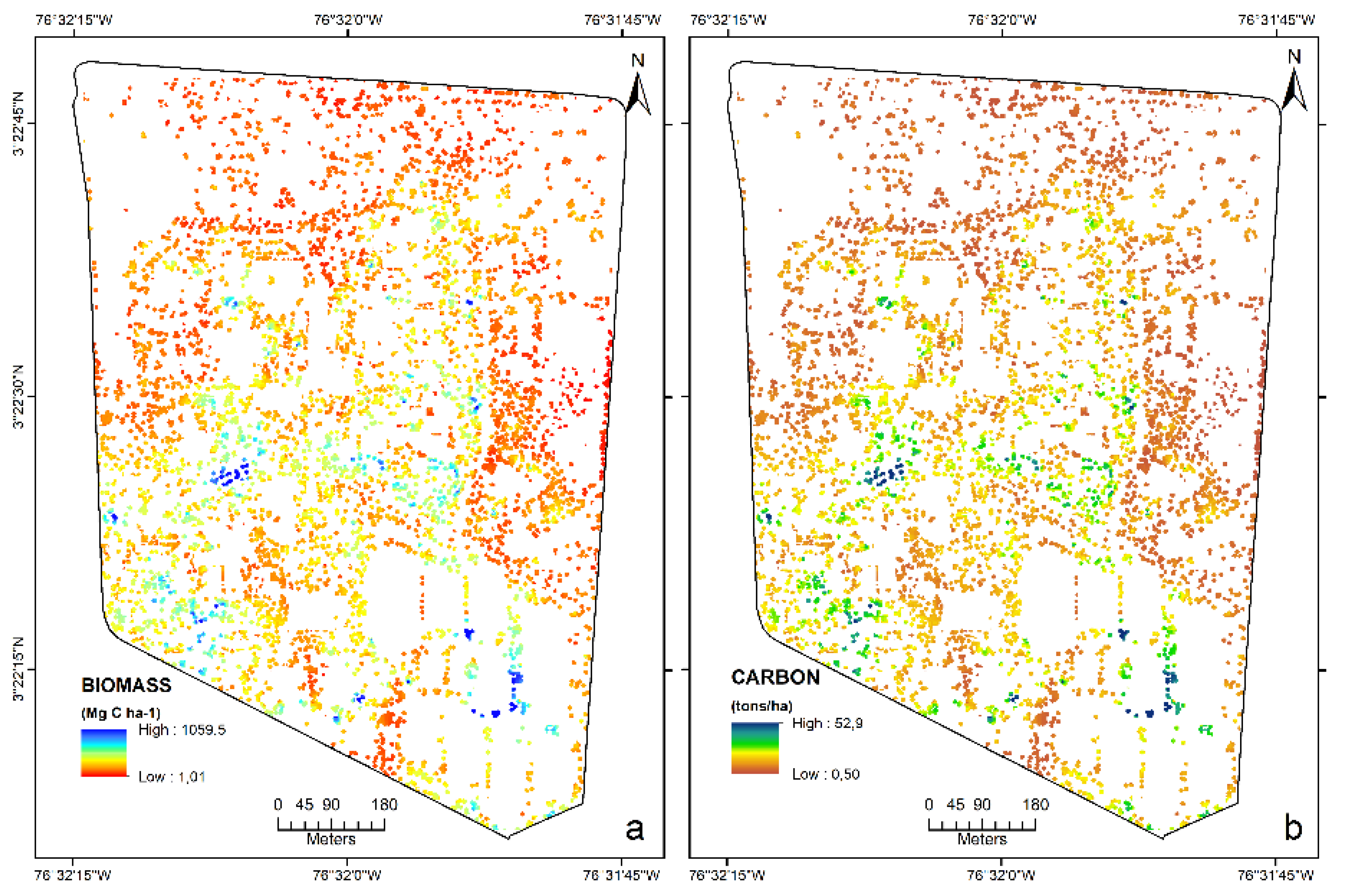
| Place | Technique | Ecosystem | Reference |
|---|---|---|---|
| Kuwait | Allometry, UAV | Shrub | Abdullah et al., 2021 [11]. |
| Kuwait | Allometry, UAV | Shrub | Abdullah et al., 2021 [13]. |
| Canada | Allometry, UAV | Woody vegetation | Sankey et al., 2021 [14]. |
| Italy | Allometry, UAV | Poplar plantations | Chianucci et al., 2021 [15]. |
| Canada | Allometry, UAV | Cultivation | Song et al., 2021 [16]. |
| Iran | Allometry, UAV | Forest | Fakhri and Latifi, 2021 [17]. |
| Italy | Allometry, UAV | Forest | Matese et al., 2021 [18]. |
| Costa Rica | Allometry, UAV | Forest | Hernández-Cole et al., 2021 [19]. |
| Ecuador | Allometry, UAV | Forest | Guascal et al., 2020 [20]. |
| Colombia | Allometry, UAV | Mangrove | Fuentes, 2020 [21]. |
| Australia | Allometry, UAV | Mangrove | Navarro et al., 2020 [22]. |
| Australia | Allometry, UAV | Mangrove | Jones et al., 2020 [23]. |
| Portugal | Allometry, UAV | Forest | Fernandes et al., 2020 [24]. |
| Ecuador | Allometry, UAV | Forest | González et al., 2019 [25]. |
| Germany | Allometry, UAV | Forest | Ye al., 2019 [26]. |
| Nepal | Allometry, UAV | Forest | Panday et al., 2019 [27]. |
| China | Allometry, UAV | Forest | Lin et al., 2018 [28]. |
| Place | Technique | Environment | Reference |
|---|---|---|---|
| Poland | GIS, UAV | Terrain | Puniach et al., 2021 [29]. |
| Turkey | GIS, UAV | Roads | Biçici and Zeybek, 2021 [30]. |
| Saudi Arabia | GIS, UAV | Infrastructure | Elkhrachy, 2021 [31]. |
| Greece | GIS, UAV | Terrain | Valkaniotis et al., 2021 [32]. |
| China, Kyrgyzstan | GIS, UAV | Archeology | Sarașan et al., 2020 [33]. |
| South Korea | GIS, UAV | Infrastructure | Jeong et al., 2020 [34]. |
| Colombia | GIS, UAV | Infrastructure | Fuentes et al., 2020 [35]. |
| USA | GIS, UAV | Infrastructure | Park et al., 2019 [36]. |
| South Korea | GIS, UAV | Terrain | Lee et al., 2019 [37]. |
| China | GIS, UAV | Construction | Liu et al., 2019 [38]. |
| Malaysia | GIS, UAV | Construction | Al-Najjar et al., 2019 [39]. |
| Greece | GIS, UAV | Construction | Mavroulis et al., 2019 [40]. |
| Greece | GIS, UAV | Archeology | Nikolakopoulos et al., 2017 [41]. |
| Italy | GIS, UAV | Construction | Vacca et al., 2017 [42]. |
| Poland | GIS, UAV | Infrastructure | Banaszek et al., 2017 [43]. |
| China | GIS, UAV | Construction | Chen et al., 2016 [44]. |
| Criterion 1 (Setting and Infrastructure (SI)) | UAV–GreenMetric Data | Campus % |
|---|---|---|
| Total campus area | 979,123 m2 | 100% |
| Total campus ground floor area of buildings | 95,598 m2 | 9.75% |
| Ratio of open space area to total area | 97.81% | |
| Total area on campus covered in forest vegetation | 430,551 m2 | 43.96% |
| Total area on campus covered in planted vegetation | 374,949 m2 | 38.29% |
| Total area on campus for water absorption | 79,062 m2 | 8.06% |
| Total open space area divided by total campus population | 39.14 m²/person |
| Variable | Average | Total Campus Area |
|---|---|---|
| Aerial biomass (Mg C ha−1) | 87.12 | 4569 |
| Carbon content (tons/ha) | 43.56 | 2284 |
| CO2 equivalents (tons CO2-e) | 160 | 8384 |
Publisher’s Note: MDPI stays neutral with regard to jurisdictional claims in published maps and institutional affiliations. |
© 2021 by the authors. Licensee MDPI, Basel, Switzerland. This article is an open access article distributed under the terms and conditions of the Creative Commons Attribution (CC BY) license (https://creativecommons.org/licenses/by/4.0/).
Share and Cite
Fuentes, J.E.; Garcia, C.E.; Olaya, R.A. Estimation of the Setting and Infrastructure Criterion of the UI GreenMetric Ranking Using Unmanned Aerial Vehicles. Sustainability 2022, 14, 46. https://doi.org/10.3390/su14010046
Fuentes JE, Garcia CE, Olaya RA. Estimation of the Setting and Infrastructure Criterion of the UI GreenMetric Ranking Using Unmanned Aerial Vehicles. Sustainability. 2022; 14(1):46. https://doi.org/10.3390/su14010046
Chicago/Turabian StyleFuentes, Jose Eduardo, Cesar Edwin Garcia, and Robin Alexis Olaya. 2022. "Estimation of the Setting and Infrastructure Criterion of the UI GreenMetric Ranking Using Unmanned Aerial Vehicles" Sustainability 14, no. 1: 46. https://doi.org/10.3390/su14010046







